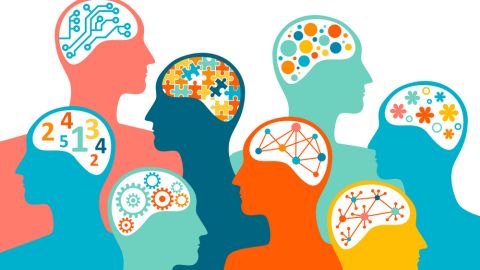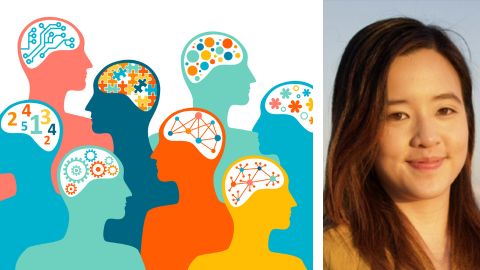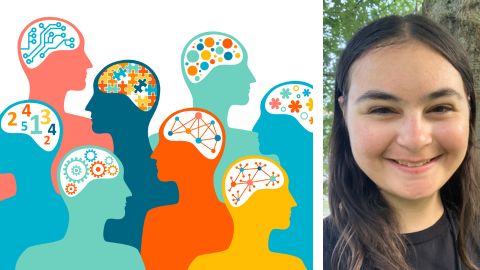Up the creek without a sequence?
My professional career began when I became a protein crystallographer, back when you could count the number of known protein structures on the fingers of one hand. Then, as now, my focus was not only to use structure to understand how enzymes work but also to develop ways to visualize these structures. Early on, I designed a popular tool for easily constructing 3D protein backbone models. This led to many commissions to create large-scale, metal molecular sculptures over the past 30 years.
 Byron Rubin stands behind a stainless steel sculpture he created. The arrow and coil representation of HIV protease with the anti-AIDS drug, Viracept, bound to it was commissioned by Pfizer for its research facility in La Jolla, California.BLAIR HORNBUCKLE
Byron Rubin stands behind a stainless steel sculpture he created. The arrow and coil representation of HIV protease with the anti-AIDS drug, Viracept, bound to it was commissioned by Pfizer for its research facility in La Jolla, California.BLAIR HORNBUCKLE
Today, among the more than 100,000 known 3D structures, one shows me in atomic detail the likely origin of my prostate cancer. Specifically, a single nucleotide change in the codon for serine 863 in one allele of my CDK12 gene blocks the tyrosine-substituted protein from binding ATP. The result? Some DNA repair processes failed, mutations escalated and my cancer began growing at an accelerated rate.
The first hint of cancer was an elevated prostate-specific antigen last December, when I was 74. When my urologist, a renowned practitioner, ordered an MRI, I went to the library to learn how to interpret the resultant images. Surely I could master MRI interpretation by reading 15 or 20 articles and reviews. Days later, after an hour in the scanner, I went home with a DVD of my images. Several hours of inspection convinced me I was in the clear. But two days later my urologist phoned. He told me I had a sizeable tumor, aggressive prostate cancer, and immediate action was necessary. So much for my MRI home study course.
While I waited for additional imaging and biopsy results, my new focus at the library was treatment, recurrence statistics and survival. To decide my best options, I read more than 100 papers. Should I undergo radiation, open or robotic prostatectomy, or do nothing? Which procedure, hospital, surgeon had the best outcomes? What were my survival statistics? Was I likely to live long enough to justify buying a new pair of shoes?
In effect, I’d become both a cancer patient and an aspiring oncologist. My years in science, I felt, should offer some benefit in making treatment choices. I had held research positions at the Fox Chase Center, Emory University, Eastman Kodak Company, Sterling Winthrop Pharmaceuticals and Harkness Pharmaceuticals, a drug-discovery company that I co-founded.
I met with two potential surgeons, a radiation oncologist, prostate cancer academic researchers, two prostate cancer support groups and a few friends who had worked through the same agonizing decisions. Oddly, doing all the research and reading both brought me closer to and distanced me from the increasing fear of my own mortality. My reading also made me realize that, should I survive cancer, life would not be the same.
DNA sequencing was just beginning to identify genes associated with prostate cancer. Could sequencing my DNA help guide my treatment either now or in the future? After reading recent papers published by my own urologist and other specialists comparing treatments, recovery times, risks and benefits, and using a nomogram predictor of my five-year survival probability, my focus shifted to learning how to get my tumor’s DNA sequenced.
 Byron Rubin stands beside a stainless steel sculpture he created for Serono (now Serono MSD) for the lobby of its Rockland, Massachusetts, facility. The sculpture is a ribbon representation of the follicle stimulating hormone peptide backbone, also showing the three carbohydrate moieties required for its activity.ROBIN REDISHI needed more than the linear DNA sequence of my tumor. I needed a detailed comparison of my cancerous and noncancerous DNA and the identification of every gene and intervening sequence that showed a difference. Fortunately, technology had brought down the price for a complete DNA sequence, but there was still the issue of interpretation.
Byron Rubin stands beside a stainless steel sculpture he created for Serono (now Serono MSD) for the lobby of its Rockland, Massachusetts, facility. The sculpture is a ribbon representation of the follicle stimulating hormone peptide backbone, also showing the three carbohydrate moieties required for its activity.ROBIN REDISHI needed more than the linear DNA sequence of my tumor. I needed a detailed comparison of my cancerous and noncancerous DNA and the identification of every gene and intervening sequence that showed a difference. Fortunately, technology had brought down the price for a complete DNA sequence, but there was still the issue of interpretation.
Perhaps I could reconstruct my complete DNA sequence and that of my tumor from a bunch of FASTQ or BAM files that I could buy for one-tenth the cost of a complete commercial analysis. My scientist hubris had been shaken. I feared that my try at interpreting raw DNA sequence data would turn out no better than my efforts at interpreting my MRI.
Though it was costly and not likely to be covered by insurance, I chose to pay for complete DNA sequencing and interpretation. I also enrolled in a clinical study in which the same information likely would be obtained. Would the analysis and interpretation be the same? The biggest questions that remained were the following: What gene changes could be seen in my cancer? And would a precision-medicine-based treatment be available for me now or in the future?
Five months after robotic surgery in June, the answer came, and though I’d read articles identifying genes involved with prostate cancer, I wasn’t ready for what my sequence analysis showed. Eighty-eight cancer-related genes were different from my germline sequence. Some genes were missing; others showed an increased copy number. Some showed single nucleotide changes. Others showed frame shifts. Of all of these variations, the changes in cyclin-dependent kinase 12, CDK12, stood out. Both alleles of this gene had mutated. One was the S861Y mutation I mentioned earlier, and the second was a frameshift mutation at residue 1054. The two mutations each produced inactive enzymes. As a consequence, my tumor had impaired DNA repair.
The good news was that if my cancer recurred, which I had been told was very likely, there was a treatment, a treatment that would not have been considered had I not chosen to have my DNA sequenced.
My wife feels strongly that changing my eating style to a whole-food, plant-based, oil-free diet will prevent recurrence. Indeed, I’ve lost a lot of weight, and my 20 years of insulin dependence is now history. While yielding to my wife’s well-researched and very thoughtful survival plan, however, I take comfort in knowing that my DNA sequencing gives me an alternative, should I need it. I might have had no alternative to traditional treatment had I not known about the potential value of DNA sequencing.
And, oh yes, I bought the shoes.
Enjoy reading ASBMB Today?
Become a member to receive the print edition four times a year and the digital edition monthly.
Learn moreGet the latest from ASBMB Today
Enter your email address, and we’ll send you a weekly email with recent articles, interviews and more.
Latest in Opinions
Opinions highlights or most popular articles

Sketching, scribbling and scicomm
Graduate student Ari Paiz describes how her love of science and art blend to make her an effective science communicator.

Embrace your neurodivergence and flourish in college
This guide offers practical advice on setting yourself up for success — learn how to leverage campus resources, work with professors and embrace your strengths.

Survival tools for a neurodivergent brain in academia
Working in academia is hard, and being neurodivergent makes it harder. Here are a few tools that may help, from a Ph.D. student with ADHD.

Hidden strengths of an autistic scientist
Navigating the world of scientific research as an autistic scientist comes with unique challenges —microaggressions, communication hurdles and the constant pressure to conform to social norms, postbaccalaureate student Taylor Stolberg writes.

Black excellence in biotech: Shaping the future of an industry
This Black History Month, we highlight the impact of DEI initiatives, trailblazing scientists and industry leaders working to create a more inclusive and scientific community. Discover how you can be part of the movement.

Attend ASBMB’s career and education fair
Attending the ASBMB career and education fair is a great way to explore new opportunities, make valuable connections and gain insights into potential career paths.

